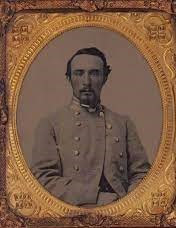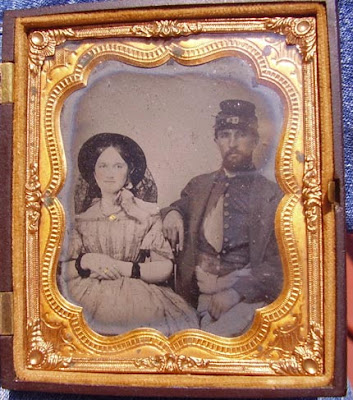What’s in a Name? Company Monikers at Stones River
When our ancestors went off to participate in the Civil War as volunteers, nearly all of them went off to war as part of a specific company and in many ways, the company became the soldier’s new family away from home. Men signed their names to an enlistment roll under the authority of a captain or lieutenant and became part of that officer’s company serving alongside their family members and neighbors.
Companies usually were raised in a defined geographical region, whether it be a city, town, or county and as such the men took a great deal of pride in belonging to Captain Stafford’s company or Captain McMahon’s company. The company took a soldier’s first claim to loyalty, quickly to be followed by membership in a regiment. Once a company was attached to a regiment, the regimental commander would designate a letter for each company, therefore assigning the company its place in the regimental line. Standard army practice called for the companies to be organized into line thus:
B- G- K- E- H Colors C- I- D- F- A
Generally speaking, date of seniority
in rank of the various captains played an important role in this initial
designation of company letter and as can be imagined, there was considerable
politicking and jockeying among the company captains for the right to be
designated as one of the flank companies (Co. A or Co. B), the top two spots in
the regimental line. Besides establishing seniority (and placing them one step
closer to promotion to field rank), the captains knew that the flank companies usually
drew rifles instead of smoothbores and would receive additional training in
skirmishing tactics, so the jockeying for position had some practical benefits
to the volunteers. Failing to secure one of those coveted spots, the officers
would turn their attention to securing the right to be either Co. C or Co. H,
giving them a chance to be designated the color company.
In the early days of the war,
many companies decided to adopt monikers to further distinguish their companies.
While there certainly was nothing wrong with being a member of Co. E, it was
far more satisfying to the men’s pride to state that they were members of Odin’s
Rifles or the Red River Dixie Boys. The sheer variety of names the soldiers
came up with to distinguish their companies is staggering and runs the gamut from
the blunt and direct to the entirely whimsical.
Taking a representative sample,
I studied the order of battle for both armies at the Battle of Stones River and
took note of the company nicknames throughout the armies. In became clear that
the practice was far more popular in the South than in the North and in some
states (like Mississippi) it was well-nigh universal. It does appear that the later
in the war that a regiment mustered into service, the less likely it became
that its companies would have nicknames. The practice of naming companies
seemed to have died out rather quickly in the North and whereas I had literally
hundreds of nicknames associated with Confederate regiments, I could scarce
come up with 30 names associated with Union regiments.
In a typical Southern infantry
regiment like the 27th Mississippi (although not that typical as it
had 11 companies instead of 10!), each of the companies had a nickname as denoted
below:
Company B- “Rosin Heels”
Company C- “Fredonia Hards”
Company D- “Rayburn Rifles”
Company E- “Leake Guards” or “Leake Rovers”
Company F- “Covington Fencibles”
Company G- “Kennedy Guards”
Company H- “Jasper Blues”
Company I- “Harris Rebels”
Company K- “Enfield Rifles” or “Enfield Riflemen”
Company L- “Twiggs Rifles”
In the Union
army, the 15th Wisconsin, an infantry regiment of Scandinavian volunteers
(Norwegian, Swedish, and Danish) from Wisconsin, Minnesota, and Illinois had
some of the most colorful company names in the Army of the Cumberland as shown
below:
Company B- “Wergeland Guards”
Company C- “Norway Bear Hunters”
Company D- “Norway Wolf Hunters”
Company E- “Odin’s Rifles”
Company F- “K.K.’s Protectors”
Company G- “Rock River Rangers”
Company H- “Heg’s Rifles”
Company I- “Scandinavian Mountaineers”
Company K- “Clausen’s Guards”
The nicknames
chosen by the Confederate volunteers ran a very wide gamut; dozens of companies
went off with the Rifles, Guards, or Grays appellation in their name. A quick
study of the balance shows that the names fell into a series of themes
including revenge-oriented names like the Zollicoffer Avengers or the Fishing
Creek Avengers to testaments to the men’s toughness such as the Pickens Rough
and Readys or the Fredonia Hards. Other companies chose names that sound like
modern-day high school football teams such as the Hempstead Hornets or the Middleton
Tigers.
The Southern cause closely
associated itself with the Southern patriots of the Revolutionary War, so it is
hardly surprising that some of the company nicknames reflected this association
with names like the Sons of Liberty or the Swamp Fox Guards. Southern cultural
and trade ties with Europe were strong and it was reflected in the company nicknames
with monikers such as Clan McGregor or The Danes. The conflict at its heart was
political in nature, so it is hardly surprising that companies went off to war
as the Jefferson Davis Sharpshooters, the Calhoun Escopets, or the Barbour
Yankee Haters.
So many of the volunteers were
young men in the 20s (or younger) so its not surprising that they adopted
nicknames like the Tuscaloosa Plough Boys, the Hawkins Boys, or the DeSoto
Brothers. Nicknames mentioning firearms were popular leading to monikers such
as the Pine Woods Sharpshooters, the Yell Rifles, or the Mulberry Riflemen. Some
of the companies really let their imagination run wild, coming up with names
such as the Moody True Blues, the Ouachita Voyageurs, the Obion Avalanche, and my
personal favorite, Little George Mathew’s Friends.
That said, knowing how popular
top 10 lists are and just to have a bit of fun with the topic, here are my top
10 company nicknames for units that took part in the Battle of Stones River.
Top 10 Union
Company Names at Stones River
The
Reapers- Co. I, 75th Illinois
Norway
Bear Hunters- Co. C, 15th Wisconsin
Senecas
and Wyandots- Co. D, 49th Ohio
Cowling
Videttes- Co. K, 26th Ohio
Hibernian
Guards- Co. F, 1st Ohio Infantry
Young
America Guards- Co. C, 36th Illinois
Ripley Rovers-
Co. D, 37th Indiana
Sanilac
Pioneers- Co. D, 10th Michigan
Garibaldi
Rifles- Co. H, 24th Ohio
Fort Meigs Rifles- Co. C, 21st Ohio
Top 10
Confederate Company Names at Stones River
Southern
Rejectors of Old Abe- Co. B, 41st Mississippi
Little
George Mathew’s Friends- Co. I, 25th Alabama
Barbour
Yankee Haters- Co. A, 45th Alabama
Sunny
South Guards- Co. K, 4th Florida
Beauregard
Relief- Co. K, 10th Mississippi
Cedar
Snags- Co. K, 4th Tennessee Cavalry (Smith’s)
Fredonia
Hards- Co. C, 27th Mississippi
Dougherty
Hussars- Co. B, 2nd Georgia Cavalry
Tuscaloosa
Plough Boys- Co. G, 38th Tennessee
Obion Avalanche- Co. H, 9th Tennessee
Beauregard-themed
The Beauregards- Co. G, 154th Tennessee
Beauregard Relief- Co. K, 10th Mississippi
Political-themed
Jefferson Davis Sharpshooters- Co. D, 7th
Mississippi
Southern Rejectors of Old Abe- Co. B, 41st
Mississippi
Calhoun Escopets- Co. A, 4th Arkansas
True Mississippians- Co. B, 30th Mississippi
Revenge-Oriented
Zollicoffer Avengers- Co. I, 33rd Alabama
Donelson’s Avengers- Co. C, 38th Tennessee
Fishing Creek Avengers- Co. D, 29th Mississippi
Jackson Avengers- Co. F, 3rd Georgia Battalion
Yankee Terrors- Co. A, 8th Mississippi
Barbour Yankee Haters- Co. A, 45th Alabama
RevWar Related
Sons of Liberty- Co. K, 154th Tennessee
Swamp Fox Guards- Co. I, 10th South Carolina
Stars
Dixie Stars- Co. I, 3rd Florida
The Western Stars- Co. A, 31st Tennessee
Guards
Sunny South Guards- Co. K, 4th Florida
Hermitage Guards- Co. I, 20th Tennessee
Roughs & Toughs
Walker Roughs- Co. D, 16th Louisiana
Pickens Rough and Readys- Co. A, 19th Alabama
Fredonia Hards- Co. C, 27th Mississippi
Lauderdale Invincibles- Co. G, 4th Tennessee
Infantry
Insurgents- Co. B, 45th Mississippi
Rangers
Bogue Chitto Rangers- Co. B, 5th Mississippi
Floyd Bush Rangers- Co. G, 3rd Alabama Cavalry
Creole Chargers- Co. G, 1st Louisiana Cavalry
Animal-Related
Hempstead Hornets- Co. B, 4th Arkansas
Middleton Tigers- Co. F, 9th Tennessee
Buena Vista Hornets- Co. H, 24th Mississippi
The Forked Deer Volunteers- Co. I, 13th Tennessee
European-Related
Clan McGregor- Co. D, 1st Arkansas
Dougherty Hussars- Co. B, 2nd Georgia Cavalry
The Danes- Co. K, 6th Tennessee Infantry
Gotten Zouaves- Co. B, 6th Tennessee Infantry
Gun-Related
Pine Woods Sharpshooters- Co. G, 16th Louisiana
Yell Rifles- Co. C, 15th Arkansas
The Mulberry Riflemen- Co. K, 8th Tennessee Infantry
Enfield Rifles- Co. K, 27th Mississippi
Just with the Boys
Red River Dixie Boys- Co. E, 11th Texas Cavalry
The Tuscaloosa Plough Boys- Co. G, 38th Tennessee
The Hawkins Boys- Co. K, 19th Tennessee
The Railroad Boys- Co. F, 1st Tennessee Infantry
DeSoto Brothers- Co. I, 29th Mississippi
Whimsical
Moody True Blues- Co. D, 8th Mississippi
Ouachita Voyageurs- Co. D, 6th Arkansas
The Forest Rovers- Co. D, 33rd Tennessee
Obion Avalanche- Co. H, 9th Tennessee
Little George Mathew’s Friends- Co. I, 25th
Alabama
The Deyampert Warriors- Co. E, 28th Alabama
Cedar Snags- Co. K, 4th Tennessee Cavalry (Smith’s)














Comments
Post a Comment